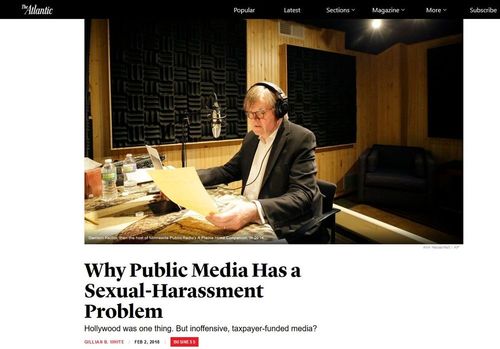From The Atlantic:
Why Public Media Has a Sexual-Harassment ProblemHiring more black guys would no doubt have solved NPR’s sexual harassment problems.Hollywood was one thing. But inoffensive, taxpayer-funded media?
GILLIAN B. WHITE 7:00 AM ET BUSINESS
… Within the span of a few weeks, accusations against other high-ranking and well-known figures have surfaced in the public-broadcasting realm, leading to their dismissal or suspension from organizations including NPR, WNYC, and WBUR. There was David Sweeney and Michael Oreskes and Charlie Rose. And John Hockenberry, Tom Ashbrook, Leonard Lopate, and Jonathan Schwartz. There’s something odd about how many of the allegations of sexual misconduct in the media industry have come out of public media—with its reputation for thoughtfulness and civility. Hollywood was one thing, with its legacy of casting couches, hypersexualization of women, and clear gender imbalances—but gentle, egalitarian public radio? …
Still, even with its well-known deficiencies, public media doesn’t quite fit the stereotypes of a male-dominated, hostile work environment. Vivian Schiller, the former CEO of National Public Radio, told me that public broadcasting, particularly NPR, has long been considered a space where women can thrive. “When I was there, most of the leadership was women,” Schiller said. In fact, four women, Cokie Roberts, Nina Totenberg, Linda Wertheimer, and Susan Stamberg, are often referred to as the “founding mothers” of NPR. And the organization’s most recent data on newsroom makeup shows that more than half of newsroom employees are women. The fact that a culture of harassment and bullying were allowed to fester for for years, all while women sat in positions of power and control, makes the issue all the more confusing. But if you consider the discord on other issues, such as between public media’s stated commitment to diversity and its predominantly white audiences and newsrooms, it’s clear that the overarching vision of public broadcasting often doesn’t manifest in real and critical ways.
… For now though, most stations I spoke with are still in the process of conducting investigations to determine just how far issues of discrimination go, and what systems have allowed them to flourish. As public broadcasting attempts to cope with its #MeToo moment, leadership will have make sense of the dissonance of widespread sexual harassment in a space known for nurturing women’s careers. They may find themselves facing other contradictions, as well— such as persistent racial inequality in a space that has a mandate to be thoughtful about diversity. Stations have an opportunity not only to contend with individual harassers or failing policies, but to also think broadly about how to create newsrooms that live up to the values public media purports to uphold.It’s almost as if supply and demand matters. The more attractive women there are relative to the number of important men, the more the guys can get away with. In Hollywood, for example, there are so many beautiful and ambitious women that the grotesque Harvey Weinstein can be Mr. Eligible Bachelor. In contrast, in fields where women are rare, they are treated better than in more feminine fields.
But nobody wants to understand this because the intended Use of Weinsteingate is more affirmative action hiring and promotion for women. That this will just further imbalance Supply and Demand, leading to more scandals and more demands for more affirmative action.











